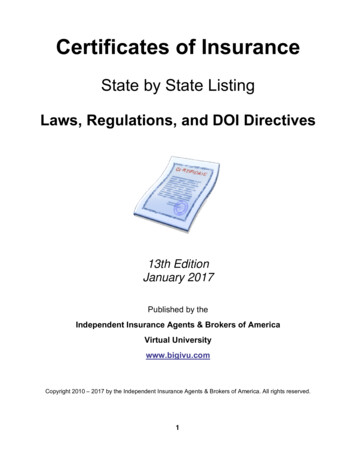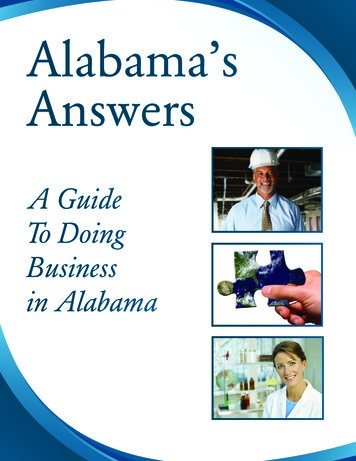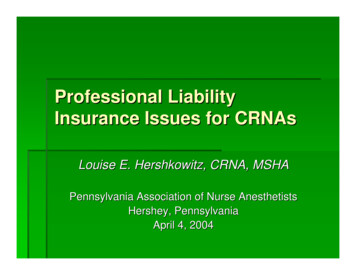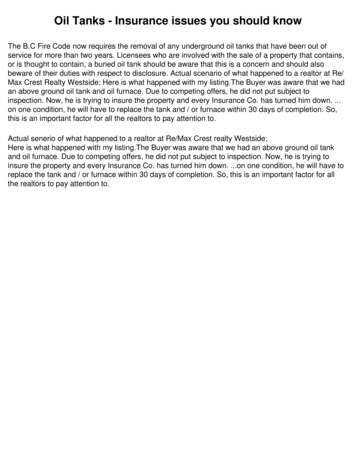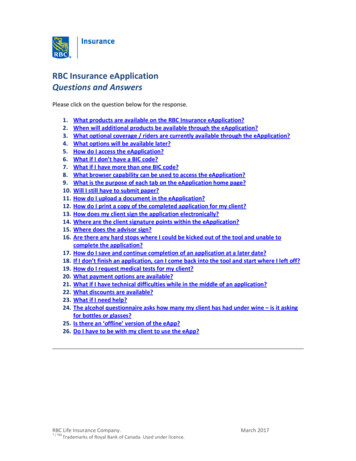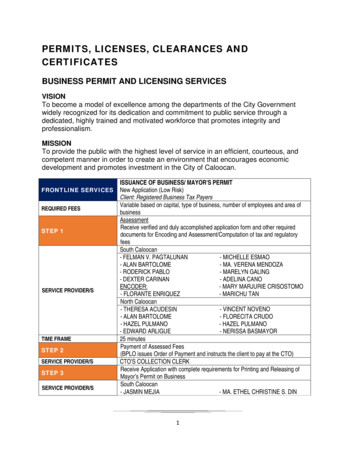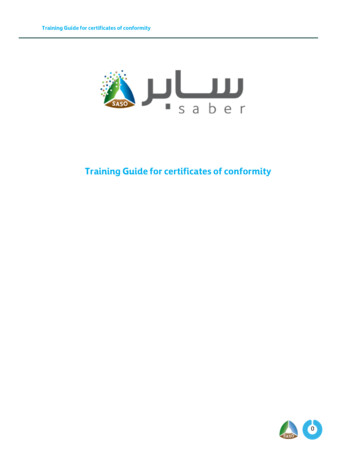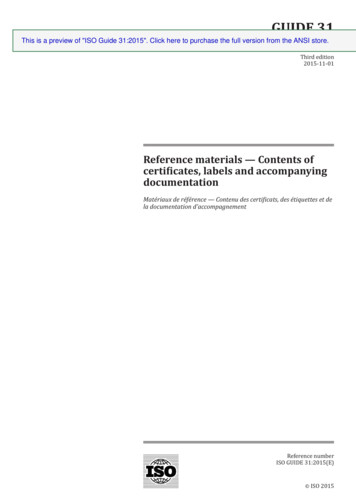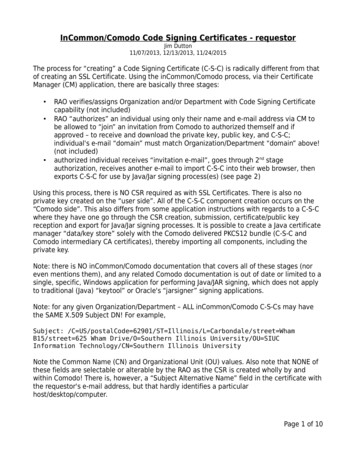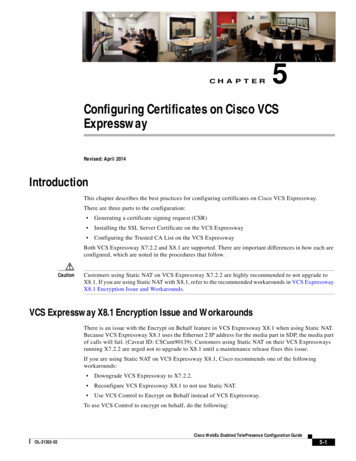
Transcription
Certificates of InsuranceIssues & AnswersSecond EditionMarch 2008Copyright 2006-2008, Independent Insurance Agents & Brokers of America, Inc. All rights reserved.CERTIFICATES OF INSURANCE: ISSUES AND ANSWERS
DISCLAIMER AND COPYRIGHTPage 2DisclaimerThe purpose of this paper is to assist agents and brokers in considering issues relevant to certificates of insurance. The paper includes only general information, and is not intended to provideadvice tailored to any specific insurance situations. It was prepared solely as a guide, and is not asubstitute for agents and brokers independently evaluating any relevant business, legal or otherissues, and is not a recommendation that a particular course of action be adopted. If specific advice is required or desired, the services of an appropriate, competent professional should besought.CopyrightCopyright 2006-2008 Independent Insurance Agents & Brokers of America, Inc. All rights reserved.No part of this publication may be reproduced, stored in a retrieval system, or transmitted in any form ormedia or by any means, including without limitation electronic, mechanical, and recording, except forbrief quotations in printed reviews, and for the worksheets in the Appendix to be used by the authorizedrecipient of this publication, without the prior written consent of the Independent Insurance Agents &Brokers of America, Inc.Certificates of Insurance: Issues & AnswersSecond Edition, March 2008Written by:William C. Wilson, Jr., CPCU, ARM, AIM, AAMwith contributions by volunteer members of the Faculty of the Big “I” Virtual UniversityDesign and Layout by:Jennifer Becker, IIABAThe most recent edition of this document can be found at , along with a number of related documents and articles.CERTIFICATES OF INSURANCE: ISSUES AND ANSWERS
TABLE OF CONTENTSPage 3Acknowledgements4Preface5Introduction7E&O Statistics & Case StudiesScope of the ProblemConstruction ContractsContractual Insurance RequirementsReviewing Contracts for InsuredsPrimary and Non-ContributoryWaiver of SubrogationNotice of CancellationContractual Liability vs. Additional Insured StatusCertificate vs. Policy Limits13Policy and Processing Forms25Additional Insured EndorsementsACORD FormsACORD 24 – Certificate of Property InsuranceACORD 25 – Certificate of Liability InsuranceACORD 27 – Evidence of Property InsuranceACORD 28 – Evidence of Commercial Property InsuranceCopyright IssuesNon-ACORD Forms, Agency/Company Agreements and E&S MarketsAgency Certificate ProceduresStatutes and Regulations36Special SupplementCourt Cases37Special SupplementConclusions38AppendixCertificate ChecklistAdditional Reading & ResourcesHow to Access the Big “I” Virtual UniversityHow to Subscribe to the FREE VUpoint Newsletter42CERTIFICATES OF INSURANCE: ISSUES AND ANSWERS
ACKNOWLEDGEMENTSPage 4AcknowledgementsThe foundation for this document is a series of Virtual University web site articles written by myself andmembers of our 50-person volunteer faculty and published in our free bi-weekly email newsletter, TheVUpoint.To subscribe to this free newsletter, go mThis foundation of information was supplemented by literally hundreds of emails, articles, andconversations with insurance and risk management professionals from around the country.Once the draft of this paper was completed, I distributed it to over 100 agents, consultants, educators,attorneys, and risk managers for their feedback.In particular, I’d like to thank author, speaker, and consultant Don Malecki for his thoughtful comments,several that I’ve quoted liberally within the text of this document. In addition, thanks to Joel Volker ofACORD and the staff at Westport Ins. Co., the E&O carrier for most IIABA members, for all of theirhelpful suggestions.In March 2008, after our board of directors adopted a position paper on certificates of insurance, webegan to offer this white paper and related documents and articles for free to the general public. Toaccess our Certificates Resources section of the public area of our Virtual University web site, go htmFinally, throughout this paper, you will find web links to information on our web site as well as others.Most of these links take you to the public area of our web site. However, because the vast majority ofour 4,000 pages of content is proprietary, some of these links require a login and are accessible only toIIABA members and paid VU subscribers. If you are interested in membership or subscription, go htmBill Wilson, CPCU, ARM, AIM, AAMDirectorBig “I” Virtual UniversityJanuary 2007—March 2008CERTIFICATES OF INSURANCE: ISSUES AND ANSWERS
PREFACEPage 5Preface“A certificate of insurance is a document issued by or on behalf of an insurance company to a third partywho has not contracted with the insurer to purchase an insurance policy. The most common type ofcertificate is that provided for informational purposes to advise a third party of the existence and amountof insurance issued to the named insured.” (Allan D. Windt, Insurance Claims and Disputes, 4th ed.,2001)These informational certificates are usually issued in conjunction with a contractual relationshipbetween a third party and the named insured, requiring that the named insured have a particular amountand type of insurance. Such requirements are particularly common in construction contracts with largecontractors, government entities, and major corporations.In addition to describing the insurance available to the named insured, a certificate may also conveyinformation that the certificate holder is an additional insured under the policy issued to the namedinsured, thus giving the certificate holder some interest in the policy itself.According to the 8th Edition of Black’s Law Dictionary, a certificate of insurance is “A documentacknowledging that an insurance policy has been written, and setting forth in general terms what thepolicy covers.” Certificates are simply snapshots of basic policy coverages and limits at the time ofissuance of the certificate. Certificates are not intended to modify coverages or change the terms of theinsurance contract.From the insurance agency’s perspective, problems with certificates most often arise when they arerequested by insureds in response to business contracts that seek to hold them responsible for “any andall liabilities” or similar wording.In addition, the certificate holder may request the insured to ask the insured’s agent for a letter attestingto the fact that “in the opinion of the agent, the policy contains the required insurance coverages/indemnifications required by the contract with the insured.” These words are excerpted from an actualletter received by an agent on behalf of his insured.In this instance, the certificate holder is demanding that the insured’s agent warrant coverage to theirbenefit without exclusions, something that is impossible to do. In addition, the contract might requirethat the certificate holder be named as an additional insured (something the insurer may or may not bewilling to do), be provided notice of cancellation (something not often provided for in an insurancecontract for additional insureds), or be provided with a type of coverage (e.g., completed operations) thatthe insurer cannot or will not provide. Such contracts may specify certain endorsements by form numberand edition date that the insurer cannot provide because they have been superseded by newer editionsand the older ones have been withdrawn.As a result, agents are sometimes asked to produce a certificate that cannot comply with the contract theinsured has signed. Refusing to do so, agents are often faced with an assertion by the insured that theyknow of agents who, according to the certificate holder, can or will provide such certificates. Failure todo the same could mean the loss of an account for the agency.CERTIFICATES OF INSURANCE: ISSUES AND ANSWERS
PREFACEPage 6To illustrate, here is an actual inquiry from an agency:Is there a ‘paper’ explaining to account managers what isautomatically included in a CGL policy, who is covered contractuallyand how the terms hold harmless, waiver of subrogation, and primarynon-contributory are addressed in the standard policy language of theCGL and commercial auto? More and more requests are coming intrying to transfer liability to another party.It is getting very difficult to explain to our employees how to handlethese requests. Once we determine what language can or cannot be puton the certificate, we then have to try to explain it to our customers.Usually, they have signed a contract agreeing to specific coveragelanguage and are then upset that it cannot be done.Unfortunately, we are considered by some clients to be the 'bad guys'that are jeopardizing their livelihoods. I'm not sure exactly what theanswer to this problem is or anything can be done about it, but maybe aclarification 'paper' would help.When IIABA members speak, IIABA staff listens. Read and enjoy.CERTIFICATES OF INSURANCE: ISSUES AND ANSWERS
INTRODUCTIONPage 7IntroductionIn this section, we’ll examine why agents need to be concerned about certificate of insurance problems,along with the scope of the problem.E&O Statistics & Case StudiesWe all know that, by and large, certificates are not contracts. So, there’s no need to be overly concernedabout the accuracy and wording on the certificate, right? Not according to E&O statistics. During thepast year of data collection, E&O claims involving certificates of insurance have increased 28%.About 1 in 25 E&O claims involves a certificate of insurance, with over half of all claims arising froman error or omission by a CSR. About 75% of E&O claims for certificates involve a CGL policy, withthe next highest category being workers compensation at 10%.The two main sources of certificate E&O claims are claims of failure to add, or improperly identifying,additional insureds (36%) and misrepresenting coverage on the certificate that doesn’t actually exist(21%). CSRs are primarily accused of being responsible for the former and producers for the latter.Agents often fall into a routine with policyholders that frequently require certificates. In these situations,the agent can become lax in checking to make sure that the coverage hasn’t changed. E&O claims havearisen from certificates issued on policies that have lapsed or certificates that indicate a specific type ofcoverage is in place when, in fact, the insured recently dropped it. This problem may be more prevalentin larger agencies where the personnel issuing certificates are different from those making policychanges. It is important, no matter what the size of an agency, that procedures be in place that requirestaff to confirm all coverages before issuing a certificate.In one recent case, the agent placed a CGL policy for a contractor that had successfully bid a projectwith the federal government. The agent issued a certificate to the government reflecting coverages as ofa certain date. Shortly thereafter, the contractor allowed its coverage to lapse due to nonpayment ofpremium. Subsequently, the contractor negligently caused damage to government property. Thegovernment sued the agent for failing to advise of the cancellation.Although a certificate is intended to be a snapshot of coverages as of the date of issuance, some nonACORD certificates require notice of cancellation. Since the agent above had unilaterally issued thecertificate, the government argued that the language created a duty on the part of the agent. Thegovernment also argued that certain federal regulations imposed a duty on the agent to update thecertificate for the lapse of coverage. As discussed later, all non-ACORD forms should be referred to theinsurer for issuance.CERTIFICATES OF INSURANCE: ISSUES AND ANSWERS
INTRODUCTIONPage 8Scope of the ProblemThere seem to be three major problems that come up often regarding certificates of insurance: (1)certificate fraud by agents and insureds, including agents who indicate coverages that don't exist so aninsured subcontractor can get a construction job or get paid for one, (2) onerous contractual insurancerequirements by large contactors, huge corporations, governmental/public entities, etc. that cannot bemet by coverages typically available in the marketplace, and (3) the issue of (not) notifying certificateholders of cancellation.Certificate fraud is an issue addressed largely by contract law, regulatory governance, and specificstatutes in some states. Certificate fraud is not limited to unscrupulous agents and, in fact, may beundertaken by insureds themselves. To illustrate one aspect of the problem, here is a recent inquiry froman agent:“I issued a GL binder for a 30-day period to a general contractor/design-build headed down toFlorida to do some work for a large city there. A lady with the city called yesterday and wantedto file a claim. I told her the coverage was canceled before the date of loss. She said my binderindicated coverage was for a 12-month term. She faxed it to me.“The contractor I assume used Excel and created his own what he called ‘ACORD InsuranceCertificate Binder 75 - (1/98).’ This thing is so real it's scary, except the spelling was as follows:“Limbirty - written five times (should be pety“Bro - for broad“Comercial“You would think a large municipality would be more diligent in scrutinizing certificates andbinders. I’m aware of some that won’t even accept them anymore they want to see the actualdailies and/or policy forms and often verify them with a phone call because of the rampantfraud.”The issue of onerous insurance requirements is largely an educational one. From the standpoint of manybusinesses and governmental entities, it doesn’t hurt to ask for the moon, even if you know you won’tget it. As one attorney noted, “I ask for everything I can get. It’s the other guy’s responsibility to say‘no.’” In many instances, these organizations are asking for concessions for which there is no insuranceproduct in the marketplace. They ask because they have the leverage to do so. Unfortunately, someagents will indicate, usually by a certificate of insurance, that their insured is in compliance with specificinsurance requirements. It could be that the additional insured isn’t concerned, knowing that the agent’sE&O insurance provides a backstop.Often organizations will ask for coverages out of ignorance. Contracts may specify additional insuredendorsements that are dated over 20 years ago. If a company (or ISO) has filed a new endorsement andwithdrawn an older one, the carrier cannot legally provide the older form without refiling it. However,some agents indicate on the certificate of insurance that the form or its equivalent is being provided.CERTIFICATES OF INSURANCE: ISSUES AND ANSWERS
INTRODUCTIONPage 9One other issue is the “will endeavor to” cancellation wording that very few insurers follow. This hasthe potential to become a legal problem, though many consider it one of ethics.is it ethical to provide acertificate that says the insurer will attempt/try (i.e., “endeavor”) to provide cancellation notice when it'sclear that the insurer has no intention of doing so?These and other issues are addressed in this paper.Construction ContractsConsider this all-too-common scenario: Your insured is bidding on aconstruction contract with a large, national builder. The contract includesan insurance addendum that requires that certain coverages, limits andterms be in place. Compliance would necessitate adding the builder as anadditional insured, restructuring the coverages, and even modifying thecoverage forms themselves (or implying that the forms have beenmodified). The builder also wants major revisions to the certificate(s) ofinsurance.Of course, the current carrier refuses to do any of this. What do you do? The insured insists that, withoutthese concessions, he will not get the job. You know that if you don't assist the insured in complying,you may lose the account to an agent who is willing and (allegedly) able to meet the builder's demands.sometimes, remarkably, with the same carrier who refused your request. Before we examine the issuesand seek some solutions, let's go back to the start .Here's a list of some of the requirements in this construction contract insurance addendum for thisbuilder, along with some commentary (Note: These are all real contract provisions.): The following additional insured endorsements must be added to the contractor's CGL policy(though it isn't clear which): CG 20 26 11 85; or CG 20 10 11 85; or CG 20 10 10 93 (but only ifmodified to delete the word “ongoing” and insert the sentence “Operations include ongoing andcompleted operations” to track the 1985 versions).oCG 20 26 11 85 - Additional Insured – Designated Person or Organization says, “WHOIS AN INSURED (Section II) is amended to include as an insured the person ororganization shown in the Schedule as an insured but only with respect to liabilityarising out of your operations or premises owned by or rented to you.”oCG 20 10 11 85 - Additional Insured – Owners, Lessees or Contractors – (Form B) says,“WHO IS AN INSURED (Section II) is amended to include as an insured the person ororganization shown in the Schedule, but only with respect to liability arising out of'your work' for that insured by or for you.”oCG 20 10 10 93 - Additional Insured – Owners, Lessees or Contractors (Form B) says,“WHO IS AN INSURED (Section II) is amended to include as an insured the person ororganization shown in the Schedule, but only with respect to liability arising out of yourongoing operations performed for that insured.”CERTIFICATES OF INSURANCE: ISSUES AND ANSWERS
INTRODUCTIONPage 10Note from the contract wording that they want the word “ongoing” deleted and replaced toensure that coverage is provided for both ongoing and completed operations. This requires thatan older withdrawn endorsement be modified, which quite possibly cannot be done by thecarrier without violating insurance laws. In addition, the wording of the referenced 1993 formwas deliberately modified by ISO to eliminate P/CO coverage for additional insureds to beginwith.Keep in mind that many insurers, particularly those that closely follow ISO filing schedules, nolonger have the requested 1985 endorsements available. The drafters of the construction contractcite the older endorsements either because they don't know newer editions exist, don't want tomodify their contract every time the forms change, or because they prefer the language of theolder forms.Sometimes endorsements are revised because of revisions in the primary policy. Using an olderendorsement with a newer primary policy could create havoc in coverage. For example, revisingan old additional insured endorsement to add completed operations coverage will create aproblem if the current primary policy form does not include that coverage for the additionalinsured (more on this below).Even more important, if the carrier has adopted a new endorsement, chances are they may belegally unable to use an older one, it having been withdrawn at the time the newer form wasfiled. It is often best if all parties work with the latest forms available, some of which may bemore appropriate for current exposures and arrangements, such as the CG 20 37 07 04 and CG31 15 10 01 cited below (forms current at the time of the publication of this paper). The additional insureds are to include the builder entities (a partnership and corporation), thesite owner, and all of their respective officers, directors, partners, members, and employees. Theadditional insured endorsements are designed to pick up incidental, largely vicarious, liabilityexposures of specific persons or organizations. The contract provision in this example basicallyexpands the contractor's CGL Who Is An Insured section to include almost everyone affiliatedwith the builder and/or owner, including office workers at the corporate headquarters. As anagent, do you realistically expect your carriers to assume that kind of exposure? The contract effectively requires that the contractor’s CGL policy continue in force to cover theadditional insureds for BI and PD that occurs after all work on the site has been completed.There is no specific termination date and, at the builder's request, the contractor must providecertified copies of all subsequent policies for at least five (5) years. This would preclude anyfuture designated premises exclusions. If the contractor goes out of business, this would appearto necessitate discontinued operations coverage. In addition, as discussed below, it is evenquestionable whether the additional insured has P/CO coverage.the modified additional insuredendorsement implies that it exists, but the current CGL policy may not grant that coverage toadditional insureds.At issue is whether this is reasonable and, as the agent, are you willing to provide this serviceindefinitely (or for at least five years) for free? Are you willing to remain vigilant in monitoringcontinuing coverages for perhaps dozens or hundreds of projects for a one-time commission? DoCERTIFICATES OF INSURANCE: ISSUES AND ANSWERS
INTRODUCTIONPage 11the rating plans in place for your carriers contemplate this broader, longer term exposure? Isyour insured willing to deplete his aggregate limit several years down the road due to a claimagainst one of these additional insureds? The contract requires thirty (30) days notice by certified mail for cancellation, nonrenewal, andmodification or reduction in coverage. It also mandates that the certificate of insurance berevised to delete the wording “endeavor to” and “but failure to mail such notice shall impose noobligation or liability of any kind upon the company, its agents or representatives” from thecancellation portion of the certificate.The contract, to the fullest extent permitted by law, also calls for the deletion of anything in thecertificate of insurance that would imply that it does not confer rights to the insurance. Thisprobably refers to the language on the ACORD 25 that says, “This certificate is issued as amatter of information only and confers no rights upon the certificate holder. This certificate doesnot amend, extend or alter the coverage afforded by the policies below.”There is significant case law to support the position that the certificate holder has no rights,under the certificate, to the insurance contract. Clearly, the builder wants to attempt to createsuch rights, even if there is no basis for requiring the carrier to do so.In addition, the back of the certificate of insurance form says, “The Certificate of Insurance onthe reverse side of this form does not constitute a contract between the Issuing Insurer(s),authorized representative or producer, and the certificate holder, nor does it affirmatively ornegatively amend, extend or alter the coverage afforded by the policies listed thereon.”The back of the form also says, “If the certificate holder is an ADDITIONAL INSURED, thepolicy(ies) must be endorsed. A statement on this certificate does not confer rights to thecertificate holder in lieu of such endorsement(s).” The contract clarifies that coverage is not limited to vicarious liability and it prohibits anyendorsement limiting coverage for ANY negligent acts, errors or omissions of the builder.Although it may or may not be the intent, this would imply that coverage goes beyond that ofthe CGL which does not cover, in a strict sense, “errors or omissions” that do not meet thedefinition of “occurrence” and result in BI or PD. It may also imply that no exclusions apply, asludicrous as that may sound. The contract forbids exclusionary language for things such as soil subsidence, earth movement,pollution, mold or fungus, EIFS, etc. How many agents represent carriers whose CGL policiescover pollution without exception? Increasingly, most policies now also exclude or limit claimsarising out of fungi and EIFS. This one provision alone makes it virtually impossible for thecontractor to comply with the contract. If insurable by law, the policy must cover punitive damages, fines or penalties. CGL policiesdon't cover fines or penalties.in fact, it's likely that an agency’s E&O policy doesn't cover themeither.CERTIFICATES OF INSURANCE: ISSUES AND ANSWERS
INTRODUCTIONPage 12 The contractor must require (and provide proof of upon request) each subcontractor to complywith the insurance requirements of the contract and the sub must sign a hold harmless/indemnityagreement specified by the contract, naming the builder, owner, officers, etc. (not the contractor)as beneficiaries. A complete subrogation waiver is also required. Unless prohibited by the policyor law, the contract requires an assignment of the policy to additional insureds if the contractoris out of business or cannot be located.The contract makes the contractor's policy primary, which isn't unusual for additional insureds.the Other Insurance condition of the 1998 CGL states that it is excess over, “Any other primaryinsurance available to you covering liability for damages arising out of the premises oroperations for which you have been added as an additional insured by attachment of anendorsement.”Note, with regard to the discussion above, that this applies only to the Named Insured, not allother additional insureds specified by the construction contract. Also note that this applies to“operations”.it does not mention completed operations as required by the contract, though onecould interpret “operations” broadly enough to include both “ongoing” and “completed”operations. This is the danger that arises when trying to apply nebulous contract provisionsacross varying editions of policy forms and endorsements.What is particularly disturbing is that coverage is required to be extended to the builder on aprimary basis for its own negligence, not just the contractor’s negligence. In fact, it makes thecontractor’s insurance primary for ALL acts of the builder. So, the contract does more thanprovide primary coverage for the builder if held liable for the contractor's actions.it attempts toprovide direct liability coverage for the builder even if the contractor isn't liable. The currentISO additional insured endorsements do not cover sole liability of the additional insured, asoutlined in this VU article:“ISO’s New Additional Insured CGL/Wilson2004AIEndorsements.htmThis agreement is a good example of a risk manager and/or attorney gone amok (not from the builder’sperspective, of course). The attempt here is to essentially remove all potentially insurable risk from thebuilder and place it on the shoulders of the contractors and subcontractors who typically have far fewerresources than the large corporations making these demands.The builder can, or can at least try to do this because of size and market clout. By passing alongsignificant costs to contractors and the insurance industry, they keep their costs lower and makethemselves even more competitive relative to other builders who don't require such onerous contracts.So, what can you, as the agent, do when faced with these types of insurance requirements imposed onyour insureds? These issues and options are what we will explore in this paper.CERTIFICATES OF INSURANCE: ISSUES AND ANSWERS
CONTRACTUAL INSURANCE REQUIREMENTSPage 13Contractual Insurance RequirementsCertificate requests often arise from contractual relationships. A client’s contractual obligations canpresent several problems for agents. First, agents are often requested to review contracts for theirclients, despite the fact that few agents have law degrees or are otherwise well versed in how tocomplete contract reviews.Second, these contracts often include undefined terms or requirements that make compliance difficult ifnot impossible. For example, parties requesting additional insured status often want the other party’sCGL to be “primary and noncontributory,” with the latter term being undefined and probablyambiguous. Waivers of subrogation are commonly requested and certificate holders invariably wantnotice of cancellation that is typically more liberal than the policy even grants the named insured.Third, there are often issues as to how additional insured status is granted and whether the CGL, in theabsence of an additional insured endorsement, might provide some coverage to another party via thedefinition of an “insured contract.”Finally, there are decisions that are steeped in ethics rather than contract law or other legal theories. Forexample, if a contract specifies a minimum liability limit but the insured’s policy provides a higherlimit, on the certificate where it asks for the limit of insurance, should the agent show the requested limitor the policy’s actual limit? Another such decision involves notice of cancellation and is discussed laterin this section.So, let’s examine each of these issues Reviewing Contracts for InsuredsIt is not uncommon for insureds to ask agents to review the insurance requirements in contracts such asleases and construction agreements in order to advise what types of insurance are needed to comply withthese contractual requirements. For example, here is how one agent says his office handles suchrequests:“Our agency permits insureds to send in copies of the contract or at least the insurance portion (Ifeel better looking at the whole contract). We will then review the insurance requirements andgive our insured a list of the insurance deficiencies and needs in the proposed coverage (if nocontract is received, we tell the insured that we have no idea if they have the proper coverage).Some insurance deficiencies can be remed
According to the 8th Edition of Black’s Law Dictionary, a certificate of insurance is “A document acknowledging that an insurance policy has been written, and setting forth in general terms what the policy covers.” Certificates are simply snapshots of basic policy coverag
